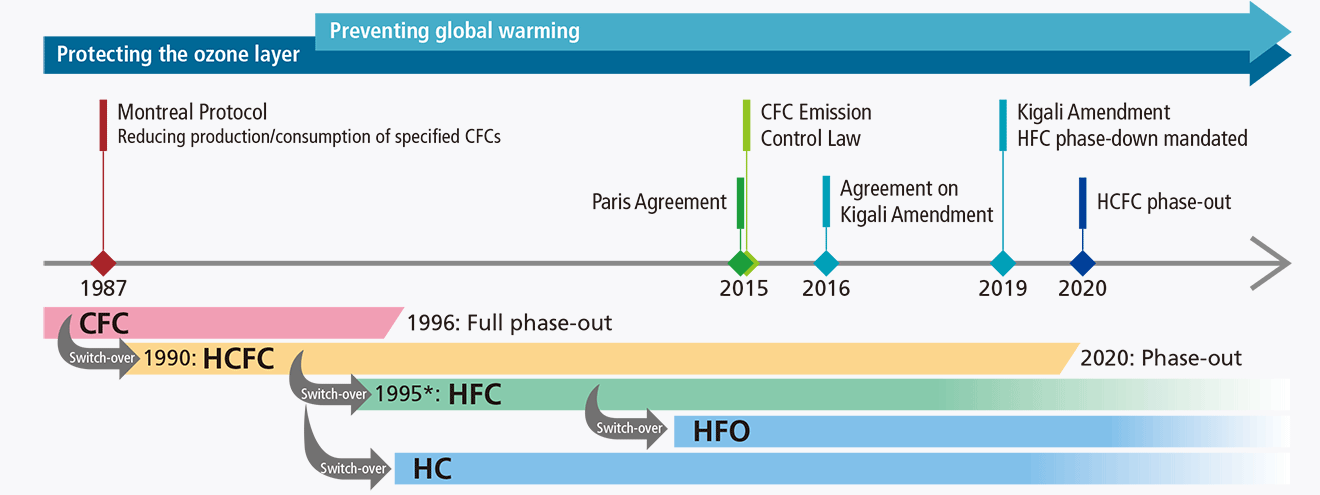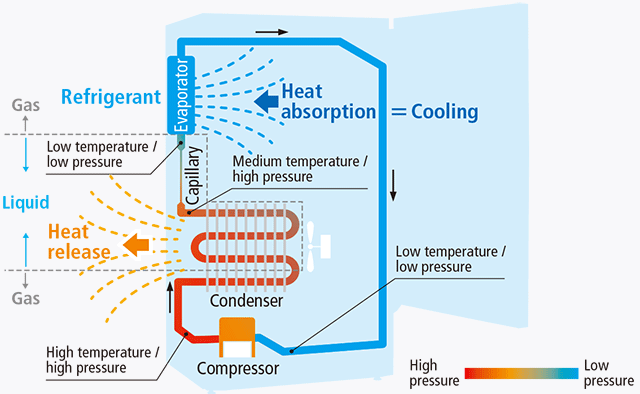2020 Issues

The year 2020 saw the move to restrict all new production of specified refrigerants such as HCFCs and the importation of these types of refrigerants because they deplete the ozone layer. Models produced up to and including 2020 may continue to use former refrigerants.
Former refrigerants drastic price rises

To exploit the situation before the complete phase-out, prices for former refrigerants were starting to increase. Using former refrigerator models that rely on HCFC use will not necessarily become impossible as of right now, but servicing and maintaining such refrigerators could become a very high expense.
Planning for equipment

Considering the increasing cost of servicing / maintaining such equipment as well as costs from unexpected equipment failure at any time, it is advisable to plan in advance for eventual equipment replacement of units currently in use. This can be with new models or taking other measures, always keeping in mind the current world situation regarding these issues.
A look at refrigerants post 1990
Changes in refrigerants used
CFCs (chlorofluorocarbons) deliver superior chemical properties together with high cooling performance, and are also quite affordable. These significant advantages gave CFCs much potential for use as refrigerants. In particular, CFC consumption soared when cooling applications expanded to include automobile air conditioners and home air conditioners. Sometimes afterward came the discovery that CFCs cause the ozone layer to be depleted.
The Vienna Convention for the Protection of the Ozone Layer was adopted in 1985 and this was followed by the Montreal Protocol in 1987. From that year, all member states of the United Nations banned in stages the use of CFCs and HCFCs as they had the potential to cause a hole in the ozone layer. This then saw HFCs, HFOs, and HCs begin to be used as refrigerants, replacing CFCs/HCFCs.
Then in 2016, the Kigali Amendment to the Montreal Protocol was made.
This effected similar measures to also gradually reduce the production and consumption of HFCs because of their potential to cause global warming.
The schedule for implementing controls varies by nation or region but the production and consumption of most HFCs have been phasing down since 2019.
| Refrigerant Types |
ODP |
GWP |
Regulations |
Specified
CFCs |
CFCs |
Chlorofluorocarbons |
High |
Very high |
Full phase-out
(scheduled for some substances) |
| HCFCs |
Hydrochlorofluorocarbons |
Very low |
Very high |
CFC/HCFC
replacements |
HFCs |
Hydrofluorocarbons |
0 |
High |
Phased replacement |
| Low GWP |
HFOs |
Hydrofluoroolefins |
0 |
Low |
None |
| Natural refrigerants CFC-free |
HCs |
Hydrocarbons |
0 |
Minimal |
| CO2 |
Carbon dioxides |
0 |
Minimal |
ODP (Ozone Depleting Potential)
GWP (Global Warming Potential)
Regulations on CFCs/HCFCs and change-overs(refers to Japan only)
 * The year when PHCbi’s use of HFC began
* The year when PHCbi’s use of HFC began
About the ozone hole
The ozone layer is a region of Earth’s stratosphere that absorbs ultraviolet radiation to protect the Earth’s surface from this harmful
radiation. If old refrigerants made from CFCs reach the stratosphere, the strong ultraviolet radiation from the sun emits chlorine atoms, which react with oxygen atoms present in the ozone, to break down the ozone.
Chlorine monoxide generated through this process is an unstable substance, causing a chain reaction repeating
the chlorine atom emissions and ozone decomposition.
As the decomposition progresses, excessive thinning of the ozone layer occurs.
Because this is similar
to a hole developing in the ozone layer, it is often referred to as an “ozone hole” and has become a critical issue.

Cooling mechanism

The transition from a liquid to a gas requires energy. Changing a substance’s state causes an endothermic reaction to occur, and this absorbs heat from the surroundings to cool. Refrigerators and freezers operate with this mechanism. A refrigerant in a liquid state turns into gas, which absorbs heat to lower the temperature inside the refrigerator / freezer cabinet. The gas is then compressed to release heat, turning it back to its liquid state. This process cycle continues repeatedly.
Requirements for refrigerants
Because a refrigerant repeats phase changes from a liquid to a gas, then back again, it must be a substance that is able to effect a stable phase change in a specific condition. In addition, as a refrigerant is contained within equipment, flammability must be low and toxicity to living creatures must be minimal in the event the equipment malfunctions and causes refrigerant leakage. CFCs were developed as ideal gases for use as refrigerants as they meet such requirements. And
due to the affordable prices, CFCs were consumed in large volumes previously.
Presently, substances that reduce harm to the environment have been developed and gradually used as refrigerants in various countries. PHCbi’s products also use such new refrigerants. Government rules for disposing commercial-use refrigerator/freezers have become stricter in many countries. Please consult a specialized disposal service provider for details when needed.
Refrigerants in general use
|
HFCs |
HFOs |
HCs |
| GWP |
1400 – 10000
(relatively high) |
< 5
(greenhouse effect: low) |
< 3
(negligible) |
| Flammability |
nonflammable |
slightly flammable |
highly flammable |
| Toxicity* |
low |
low |
low |
| Ozone depleting potential |
0 |
0 |
0 |
* Low toxicity conforms to ASHRAE Class A.
Some substances may have Class B toxicity.
Summing up
The impact of refrigerants on the environment is still being debated in some countries. As such, it is important to monitor the enforcement schedule for regulations, and social trends for managing refrigerators/freezers. This includes planning to prepare for equipment failure or additional equipment installations. In the future, changeovers of refrigerants in case of equipment breakdowns can become costly. To avoid such situations, it may be necessary to plan regular purchasing for new equipment in a way to conform to social/industrial trends.
"Stay informed with the latest news from PHCbi”
